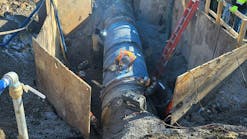Smart meters are taking center stage in modern water utilities as solutions that can increase water efficiency and improve customer relations. They are proving highly valuable to a range of organizations—from large water utilities concerned about water loss to rural water utilities troubled by severe drought.
RIVERSIDE COUNTY, CA
Drought and regulatory challenges have been driving factors in Riverside County, CA’s Eastern Municipal Water District’s (EMWD) decision to embrace smart meters to conserve water and time, and to provide better service to its growing population. As California’s sixth-largest water agency, EMWD provides services to seven cities and 795,000 individuals in Riverside County.
Prior to adopting smart meters, field technicians were manually reading 148,000 meters throughout a 555-square-mile service area.
Chicopee Rural Water District reduced water loss from 12% to 3% by installing new Kamstrup meters.
Missing and/or inaccurate data created a challenge in educating customers and in spotting leaks and limited the ability of EMWD employees to proactively review data and provide customer service options and efficiency updates.
The utility needed to monitor for high usage patterns, identify areas where customers exceeded their water budgets, and detect leaks throughout the system.
In 2008, EMWD initiated pilot testing and deployment of Automated Metering Infrastructure (AMI) in an effort to derive the benefits of leak detection, water conservation analytics, and savings in labor, fuel, and equipment.
In late 2014, the board of directors authorized a five-year meter reading service agreement to accelerate deployment of the AMI program with more than 70,000 meters installed and operating. The board also established a schedule for converting all of the district’s water meters to AMI technology by May 2019.
To improve customer service and data accuracy, EMWD deployed the Sensus FlexNet communication network. The utility now relies on the FlexNet system to read meters remotely rather than its previous practice of manual reads, with EMWD now reading more than 52,000 meters using Sensus technology.
EMWD uses FlexNet to collect accurate data in a timely manner, improve operational efficiency, generate reports for customers, conserve water, and analyze usage.
The data is helping to conserve water, with more than 2,600 customers having been contacted regarding continuous usage at their residence and more than 2,300 of them no longer showing signs of leaks.
Within two days of deploying the technology, the utility was able to identify a leak for a customer where a retaining wall in a sloped area of the backyard concealed a broken sprinkler head. The customer’s bill could have potentially doubled without that detection.
EMWD staff initiates contact via phone call, email, or text message to inform customers of elevated usage, encouraging them to do repairs.
The smart meter technology also has enabled EMWD leaders to save on human resources, as it would take an estimated eight additional staff members to manually read the meters of its growing population.
Employees now focus on analyzing data to better serve customers and assist them in water efficiency.
By implementing the latest technologies available to create an efficient environment and empower customers to conserve water, EMWD is able to limit the water lost to leaks in an economically responsible manner, points out David Gayneaux, meter services manager for EMWD.
EMWD uses an allocation-based rate structure, providing both indoor and outdoor water budgets to customers. Gayneaux notes that to help abide by state-imposed drought mandates, EMWD implements certain allowances for outdoor watering, using FlexNet to alert users if they exceed their allowance to help improve conservation efforts as well as proactively assist customers with leak detection.
A Full Pipe Insertion
Mag meter offers flow
measurement that can
be correlated with
smart meter data.
As a flexible and scalable technology, FlexNet enables accurate and reliable meter reads to accommodate the area’s growing population. Gayneaux indicates that he looks forward to expanding use of the technology to better serve customers, including the launch of a customer portal to enable users to self-monitor their consumption and make payments.
MURFREESBORO, TN
Raising the standard for customer service, increasing conservation efforts and operational efficiencies, decreasing non-revenue water, and sustaining its community’s water resources has always been on the radar for the Murfreesboro Water & Sewer Department (MWSD) in Tennessee.
MWSD had set a goal to reduce its non-revenue water by using a technology that would solve current problems while offering a potential for future growth and flexibility.
“Our system had been pretty antiquated,” notes Randy McCullough, MWSD AMI field services manager. “We had never had a changeout program. That was one of our driving factors because we wanted to get new meters in the ground. In doing that, we also wanted to update our technology, so we took the step of going to the AMI system and in doing that, we found that we had a lot of meters that were not registering correctly. We were losing a lot of water, so we changed out every meter we had that’s industrial, residential, and commercial—roughly 27,000 meters.”
In seeking to modernize its meter reading process to more efficiently manage water delivery to its 10,000 customers, MWSD chose Itron’s Advanced Metering Infrastructure (AMI) solution with acoustic leak detection and analytics software in a project that began in August 2015 and was completed in May 2017.
While monitoring the Acoustic Leak Sensors through the AMI network, a leak was detected and determined to be leaking at a rate of around 70 GPM.
“The Itron technology alerted us about the leak and allowed us to monitor the situation until we could schedule the repair at the most opportune time for our staff. The result minimized the impact on Murfreesboro citizens, as well as the local environment,” says McCullough.
The meter change-out has allowed the city’s water and sewer department to get an hourly read.
“We’re at about a 99% read rate whenever we read our cycles for billing,” notes McCullough. “We also collect hourly intervals and have bumped that up to close to 99% on hourly intervals, which are very, very good read rates for what we do. It has helped us tremendously to collect accurate and consistent readings, and has helped us with customers with leaks on their lines to be able to notify them in a reasonable amount of time.”
The Itron AMI system has resulted in a more efficient process, giving his staff the ability to complete preventative maintenance, detect leaks, reduce non-revenue water, and provide customers with actionable data, notes Darren Gore, director of MWSD.
Additionally, the city continues its focus on detecting leaks and has rolled out the customer web portal to its customers, offering them access to real-time, actionable data.
Prior to the mater change-out, it could take up to three months to notify a customer that they had a leak and it should be repaired, McCullough adds.
Murfreesboro was able to purchase the $8.5 million leak detection and meter change-out completely from a reserve fund.
“Also, we have seen a revenue increase due to the fact that we had meters that were not giving us accurate information,” adds McCullough. “In finding leaks, we have saved quite a bit. Just in the last year, we have located 64 leaks and repaired 30 leaks, saving ourselves 109 million gallons per year with an estimated production cost savings of $105,000. If a water and sewer department can do this, it’s well worth the money to install the smart meters.”
CHICOPEE, KS
With 212 meters, the Chicopee Rural Water District in Kansas is a small district, but it is also an older one—the first in the state of Kansas and second in the US, notes Ed Thompson, water operator.
Prior to adopting Kamstrup smart water meters, the district had older, traditional meters from a variety of manufacturers and sought to switch to automatic meter reading.
“It used to take me three days to read all of the meters and now it takes me two hours,” notes Thompson. “Since we’re small, we don’t have a lot of resources, so if we can cut things down as far as labor hours, it helps out.”
The district—which purchases its water from a wholesale distributor before selling it to residents—considered all options. It chose Kamstrup because it is an ultrasonic meter with no moving parts that could wear out, he says, adding that cost efficiency would be among its many benefits.
Mechanical meters can have water loss, says Thompson, adding that his district was seeing losses of about 12%. After installing Kamstrup meters, water loss has been reduced to 3%, he adds.
Smart meter data is easily accessible from smartphone or tablet.
The district is expecting to get 25 years out of the meters.
The meter change-out—which took one month—was paid in full from funds the district had on hand throughout the years. “We’ve been pretty frugal over the years,” notes Thompson.
Thompson says the district does use the meters’ removable antennas.
“That’s huge,” he says. “Other companies integrate the antenna into the meter. We’ve broken ones already and it’s not abnormal. We can replace that antenna at a $25 cost, but with another meter, you’d have to buy a whole new meter for a couple of hundred dollars. Some water districts may not need them. We’ve done some testing on our own and there is no way we couldn’t have an antenna.
“It’s not that we’re in a real wet situation but our soil can stay wet quite often and we have water in our pits. A meter can’t read through that very well; plus, our lids are metal.”
Thompson also calls it “huge” that with a Kamstrup meter, his water district can use an inexpensive tablet or smartphone without needing to purchase a field-grade laptop sold by other manufacturers to accompany their products. “If my $400 tablet goes bad, I can go buy another one and not spend a couple thousand on a laptop. That was another deciding factor.”
FINDING LEAKS FASTER
Kirk Hile, president and CEO of W.K. Hile Company—a manufacturing representative of process instrumentation—points out that while there may be automatic meter infrastructure utilized on individual buildings, “the missing link is you have these big water lines headed to that particular area and it’s a separate group of people who are tracking what is being pumped into these locations in which they have a separate system like a SCADA system.
“You’ve got the accounting people over here, and the distribution people here, and there is no communication between the two,” he adds. “The missing link is that the accounting people are not getting the information off of that main meter—they know how much they are billing, but they don’t know how much they’re feeding.”
To that end, something like McCrometer’s Full Pipe Insertion Mag meter offers an easy installation on lines 6 inches and greater, notes Hile.
“All you need is a two-inch tap to get into that line and generally distribution lines are very straight run,” he says, adding that it becomes a “cross-pollination” between metering and billing.
Flow measurement data coming from a Full Pipe Insertion mag is compared to that from the meter and “if that number does not correlate and it’s off by 20 or 30% and you look at water being money, they’re pumping water into their groundwater that they’ve spent so much money on, making it nice and clean and drinkable, and they’re losing a large amount of money because the actual invoicing of all of those water meters and the distribution meter aren’t correlated.”
In that event, water utilities can respond to a red flag to identify leaks, isolating the potential leak location down to a few miles, says Hile.
The McCrometer meter is easy to install because it doesn’t necessitate shutting down the main water line, Hile points out.
“It’s not an expensive investment when you consider that you can save tons of money by being able to track down what some of your issues are,” he says. “What many have now is pumping stations and they may have a meter close to the pumping station, but they may not have a meter 10 miles down the road. They have to look at miles and miles of piping and listen to it to see where their leak is.”









